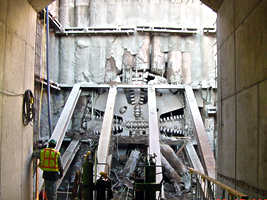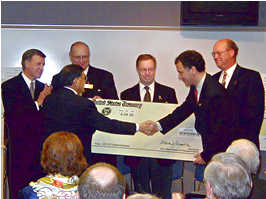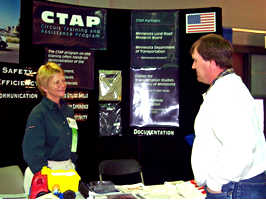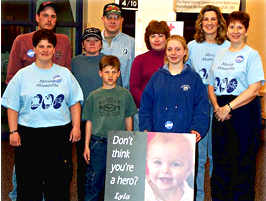 |
 |





 |
 |
 |
 |
 |
 |
LRT southbound tunnel completed as digger sees sunlight after months underground
|
 |
 |
 |
The tunnel-boring machine
digging two LRT tunnels beneath the Minneapolis-St. Paul International
Airport reached the half-way mark April 25 when it broke through these
cement caissons protecting the excavation. Consultant photo
|
Several media outlets joined local dignitaries on April 25 to greet an atypical
guest on an unusual quest: the huge, globetrotting tunnel-boring machine. The
tunnel borer broke through the ground after more than six months of chewing
rock beneath the Minneapolis-St. Paul International Airport to dig one of two
1.4-mile tunnels for the Hiawatha Line Light Rail Transit project.
Commissioner Elwyn Tinklenberg called the tunnel borer and its work a "marvel."
"We watched last August as this machine arrived in Duluth in several pieces
through the St. Lawrence Seaway and then as it traveled by night down I-35 on
side-by-side trucks," Tinklenberg said. "In October we watched as
the tunnel boring machine began chewing its way into the earth, and today we
marvel at the completion of this first tunnel."
But once the 500-ton tunnel borer finally finished digging the southbound tunnel,
it had to get to the other side of the airport and get ready to start digging
the northbound tunnel in a few more weeks.
Easier said than done.
"On Monday, crews will take the cutter head off of the machine and haul
it across the airport runways during the night," said Joshua Collins, Mn/DOT
community outreach specialist. "Over the next two weeks they will disassemble
the machine and transport it to the north portal. After another two weeks of
reassembling the machine, work will begin on the northbound tunnel. The second
tunnel is expected to be completed in October of this year."
Work has proceeded on schedule through the winter on other parts of the line,
too, Collins said.
"Work is continuing in downtown Minneapolis and we expect to see the first
rail laid at Nicollet Avenue, probably in mid-June," Collins said. "Also
in mid-June, we will start laying actual rail tracks at Park Avenue and Fifth
Street in downtown Minneapolis. In early May, we plan to begin laying track
on the mainline route, starting around Hiawatha Avenue and 26th Street in south
Minneapolis."
Construction of the Hiawatha Line is on time and within budget, Collins said.
He indicated that about 29 percent of the construction itself is complete, and
the design/build project as a whole (including design) is about 39 percent complete.
The Metropolitan Council will begin partial service on the Hiawatha Line in
2003 and full service from the Mall of America to downtown Minneapolis in 2004.
Click here for more information about the LRT
project and to read a previous Mn/DOT Newsline article on the tunnel
borer.
|
back

|
 |
SMT approves changes to Construction and Contract Administration, Materials and
Road Research
|
 |
 |
District offices and Metro Division will take on additional responsibilities
as a result of recommendations the Senior Management Team approved April 23
for the Office of Construction and Contract Administration and the Office of
Materials and Road Research.
After reviewing the options for the Office of Construction and Contract Administration,
SMT decided that no changes would be made in the areas of Permits and Agreements
and Legislative Claims. The Office of Land Management will continue responsibilities
for permits and agreement certification, and legislative claims will remain
housed in the Office of Construction and Contract Administration.
However, the districts and Metro Division will now be responsible for handling
the final review process for construction projects as well as the contract time
review process.
"This will be a substantial change for the districts and Metro on how
finals have been handled in the past where Central Office had an approval role
for both contract time and finals," said Mike Marttila, director, Office
of Construction and Contract Administration.
All areas of evaluation within the Office of Materials and Road Research will
maintain their existing processes with the exception of the design recommendation
approval process, which will shift to the districts and Metro Division as a
way to streamline the decision-making process.
"Although we will no longer be responsible for approving the design, we
will continue to assist and train the districts and Metro until they are comfortable
with the new process, said Gerry Rohrbach, director, Office of Materials and
Road Research.
The Office of Construction and Contract Administration and the Office of Materials
and Road Research will periodically conduct audits on selected projects to ensure
compliance.
These changes are part of the department’s Shaping Our Future effort, which
is systematically examining Mn/DOT’s processes—and changing them as needed—to
ensure that resources are aligned with the department’s strategic directions
and that work functions are located closest to the customer and end product.
Many of the changes also reduce the number of approvals and sign-offs, which
help expedite processes.
Other offices that have undergone or are undergoing internal review as part
of the Shaping Our Future effort include Administrative Services, Bridges and
Structures, Communications & Public Relations, Consultant Services/Contract
Management, Electronic Communications, Maintenance, Research Services and Traffic
Engineering.
Watch next week’s Mn/DOT Newsline for news about changes in the Office
of Land Management.
Click here for more information about Shaping Our Future
and to read previous Mn/DOT Newsline
articles discussing the initiative. Send questions and comments to change@dot.state.mn.us
or to Change, Mail Stop 150.
By Daneeka Marshall-Oquendo
|
back

|
 |
Mayors join transportation coalition in urging legislative compromise on funding
bill
|
 |
 |
Eight Minnesota mayors on April 30 endorsed the Minnesota Transportation Coalition’s
proposed compromise for ending the legislative deadlock on the transportation
finance bill.
The mayors of Minneapolis, St. Paul, Bloomington, Montevideo, Mankato, St.
Cloud, Rosemount and West St. Paul encouraged legislators to support:
-
A five-cent per gallon gas tax increase to provide a substantial and sustained
increase in transportation funding
-
Balanced transportation funding with an increase in annual transit funding
-
Dedication of the Motor Vehicle Sales Tax with phase-in transfer over three
years beginning in 2006
The Senate’s transportation finance bill includes a six-cent per gallon gas
tax increase, indexing, establishment of a multi-modal fund, bonding and a referendum
vote for a possible one-half cent sales tax increase in the 11-county metropolitan
area. The House version has no money for the Northstar Commuter Rail project
and includes $750 million in bonding, to be paid with growth in the transportation
fund.
Constitutionally, the Legislature must adjourn by May 20 this year.
"It is really unprecedented to have support for transportation funding from
so many different groups," said Commissioner Elwyn Tinklenberg. "With the general
public, business, labor and now so many mayors supporting the effort to provide
a long-term, statewide, multimodal transportation funding package, I hope the
Legislature will take action soon."
See also an earlier Mn/DOT
Newsline article on transportation financing.
|
back

|
 |
Oberstar Forum features multi-modal discussion on effects of Sept. 11
|
 |
 |
 |
U.S. Transportation Secretary Norman Mineta, in town for the James L.
Oberstar Forum on Transportation Policy and Technology, joined U.S. Rep.
Mark Kennedy in presenting Mn/DOT with a $2.9 million check for a new
Hwy 212 on the southwest end of the Twin Cities. From left are Robert
Lindall, Southwest Corridor Transportation Coalition; Mineta; Jim Swanson,
Program Delivery Group director; Dave Trooien, Willmar District Engineer;
Kennedy; Bob Winter, Metro Division Engineer. Photo by Kevin Gutknecht
|
Weaknesses and some surprising strengths in the nation’s transportation system
were highlighted at the first James L. Oberstar Forum on Transportation Policy
and Technology sponsored by the University of Minnesota's Center for Transportation
Studies. Held April 29 in Minneapolis, the forum focused on how transportation
agencies have responded since the terrorist attacks of Sept. 11.
"Patience is a new form of patriotism," U.S. Department of Transportation
Secretary Norman Mineta said in his keynote address.
Commissioner Elwyn Tinklenberg moderated a panel discussion that featured transportation
leaders representing transit, aviation, rail, highways, and ports and waterways.
Transit prepared
Panelist Bill Millar, American Public Transportation Association, said transit
was used to dealing with this kind of crisis. He cited the 1995 sarin nerve
gas attacks in Japan as one example of why many transit systems in the world
now have emergency response plans.
Millar noted that transit systems in New York and Washington D.C. were immediately
prepared to respond to the attacks by reversing course and carrying passengers
away from the World Trade Center and the Pentagon and that not one life was
lost in the transit system. Travelers who were displaced at airports across
the nation and Canada were able to use public transit to find temporary shelter
or to find alternate ways to return to their homes. He said Sept. 11 underscored
the need for the nation to build redundancy into the transportation system.
By air
Other modes of transportation were not as prepared. Mineta said continued economic
fallout from Sept.11 proves the nation cannot afford a fear of flying. Doug
Steenland, Northwest Airlines, added that a prime goal in the airline industry
is to restore business travel, which has fallen dramatically since Sept.11.
Panelists added that new security measures being implemented at airports must
ensure, not diminish, U.S. citizens’ freedom to travel.
By land
Matt Rose, Burlington Northern Santa Fe Corp., said rail officials considered
shutting the nation’s rail system down on Sept.11, but continued to operate.
He said the terrorist attacks have led to security changes including improvements
in the tracking of hazardous materials and eliminating haz-mat placards on rail
cars to reduce visibility.
Saying highways are needed both as avenues of exit and as avenues for help
during an emergency, John Horsley, American Association of State Highway and
Transportation Officials, said improving security on highways requires a systematic
vulnerability assessment of roads, bridges and tunnels, an emergency response
plan and cooperation with U.S. military forces to enable military activation
during a crisis. However, he pointed out, safety is also a top concern because
every three weeks the same number of people die on the nation’s highways as
died on Sept.11.
With three million truck drivers nationwide, Bill Canary, American Trucking
Association, said a prime goal for the trucking industry is to never allow a
truck to be used as a weapon.
By sea
Davis Helberg, Duluth Port Authority, said Sept.11 highlighted weaknesses in
the nation’s ports and waterways. Foremost among them is the fact that foreign-owned
shippers carry most international waterway trade. He said more information is
needed about ships before they enter U.S. waterways.
Key issues
All panelists agreed that the key issues in transportation security include
raising public awareness about the value of transportation for the economy and
for quality of life, increasing funding to address security needs, and identifying
and coordinating who is responsible for what when it comes to security. They
also agreed that redundancy in transportation is critical and that Sept. 11
showed that as a stark reality. Oberstar closed the forum by praising organizers
for breaking new ground in gathering together transportation leaders from all
modes—something, he said, that has never happened in Congress.
Work Zone Memorial
To commemorate Workers Memorial Day, the forum included a tribute to workers
who have been killed in work zones. Oberstar cited the 1,000 workers who were
killed in work zones last year, including 10 in Minnesota. Minnesota has one
of the best records in the nation on work zone safety.
By Pat Lund
|
back

|
 |
State expands Mn/DOT’s hiring freeze exemptions
|
 |
 |
The Department of Employee Relations has expanded Mn/DOT’s exemption to the
current hiring freeze so that it includes all positions directly tied to program
delivery, Mark Carlson, Human Resources director, announced April 25.
On Feb. 28, DOER restricted all state agencies from hiring any permanent or
temporary employees through June 2003. All agencies, including Mn/DOT, were
allowed some exceptions to this "freeze" in order to hire people providing
essential government services that address safety and emergency situations.
Even so, this limited Mn/DOT’s ability to deliver its construction program.
"This expanded exemption is a very positive step in ensuring we succeed
in delivering the biggest program in our history," Carlson said.
|
back

|
 |
Mn/DOT to offer training, on-going help for creating resumes
|
 |
 |
Resumes will soon replace many traditional exams and processes as the path
to employment and career management with the State
of Minnesota.
That’s because earlier this year the Department of Employee Relations announced
that it was abolishing statewide written exams. Instead, DOER is moving to a
resumes-only system managed on computer via the World Wide Web and an interactive
voice response phone line.
This change means that employees seeking other jobs within the State of Minnesota
will soon need to create resumes on paper or online. Employees will benefit
in several ways by submitting their resumes. Some of these benefits include:
-
Twenty-four hour access to view (or listen to) and apply for jobs of interest
via the Web site and the interactive voice response phone line.
-
Fewer application steps, with no more need to fill out different applications
for specific job classifications or positions.
-
Ability to make choices about applying for specific positions instead of
the job classification as a whole, like the previous system.
-
Automatic consideration for state and Mn/DOT vacancies. The system will
search for and automatically match resumes with the skills listed in the
job postings.
-
More flexibility to manage career moves.
-
Easy-to-use tools that offer more information so employees can find out
and apply for specific vacancies.
-
One simple method of applying will give employees the opportunity to easily
share this knowledge with family, friends and others who are looking for
employment with the state.
Online resumes have been the calling card for millions of job seekers in private
industry for more than a decade. DOER has also had an optional online resume
building system for several years for some job classes while also accepting
applications via fax, mail, e-mail and personal delivery.
Recently, however, job seeker and employee demand—along with a tightened job
market—has driven DOER to develop a simpler process that includes online resumes,
according to Gary Simon, recruiting and retention coordinator, Office of Human
Resources.
In order to help employees who are not familiar with resume writing or filing
online resumes, Mn/DOT’s Office of Human Resources plans to offer training classes
for employees between now and June 30. The classes will cover both resume writing
and the process of using Resume Builder, DOER’s online resume building format.
As a preliminary step, Simon indicated that Human Resources offered a "train
the trainer" class last month to employee development specialists and other
Human Resources professionals. These employees will, in turn, teach the hands-on
classes to Mn/DOT employees during the next two months.
But this is no "one-shot-and-you-miss-it" deal, as infrequently scheduled
civil service exams sometimes seemed to be. Simon said that these trained coworkers
will offer employees an equally valuable service after the classes end.
"The HR and training staffs will continue to be available as ‘consultants’
for employees who need advice on creating resumes and using the online service,"
Simon said. "We recognize that many people might have questions or need
a little help after the class. That’s why we are training people to provide
this help as a service for employees.
"Despite the hiring freeze and budget conditions, we’re still encouraging
all employees to get their resumes into the system because Mn/DOT is looking
at phasing out our current eligible lists," he said. "We want everyone
to have a resume in the system by Nov. 1 because that’s when the lists will
be abolished. When we are able to step up our hiring, we want employees to have
resumes in the database so that we can consider them when filling vacancies."
Employees who do not have computer access or who prefer not to go online will
be able to mail a resume to DOER, Simon said. DOER will use resume-scanning
software to enter these resumes into their growing database.
Simon said he also sees the new resume-writing class and post-class assistance
as an important part of retaining employees.
"We value the employees we have, and we don’t want anyone to miss out
on job opportunities," he said. "By helping employees learn the new
system, we also help ensure that skilled and knowledgeable employees are available
in the candidate pool for any vacancies that come up. We are working closely
with DOER and the unions to ensure that this process is a smooth and successful
one."
Look for additional information on this topic to come out soon. A class schedule
with dates will also be available shortly.
|
back

|
 |
Expo attracts maintenance enthusiasts to St. Cloud
|
 |
 |
 |
Kathleen Schaefer, Circuit
Training Assistance Program instructor in Maintenance Operations Research
and Standards section, discusses the program’s services with Ron Finnila,
transportation generalist at the Cannon Falls Truck Station, during the
Minnesota Maintenance Spring Expo held in St. Cloud April 24-25. Photo
by Mike Travis
|
The 2002 Minnesota Spring Maintenance Expo, held April 24-25 at the St. Cloud
Civic Center, attracted dozens of representatives from townships, cities, counties
and state interested in seeing the latest in spring and summer roadway maintenance
operations. Participants attended sessions on a variety of topics from how to
handle heavy equipment to new technology for work zones.
One highlight of the Expo that attracted much media attention was the Mobile
Traffic Monitoring System, a new way to warn motorists of traffic delays. A
live demonstration showed how MTMS would provide motorists with real-time speed
and traffic delay information before they reach a work zone.
According to Craig Mittelstadt, Office of Construction and Contract Administration,
this new technology is expected to reduce crashes in work zones because it provides
motorists with up-to-the-minute information on what's ahead and gives the motorists
an option to find an alternate route. For more information on MTMS, contact
Craig Mittelstadt at 651/296-5714.
By Shayla Cain
|
back

|
 |
May marks National Bike Month
|
 |
 |
In May, Mn/DOT is taking advantage of National Bike Month to remind the public
that bicyclists have the same rights and responsibilities as any other vehicle
driver.
"The fact that we have more paved bicycle trails than any other state
is a reflection of our commitment to providing transportation choices—including
bicycling—for Minnesotans," said Commissioner Elwyn Tinklenberg. "In
order to make bicycling a safe alternative, everyone needs to be respectful
of others’ rights to be on the road."
Bikers use roads as well as trails. Mn/DOT and its transportation partners
are expanding and improving on-road bikeways, such as shoulders and bike lanes,
so that more people can choose to bike to work, according to Mary Jackson, bike
planner in the Office of Environmental Services.
Minnesota bicycle laws
Every year, there are, on average, 1,265 crashes in Minnesota involving a motor
vehicle and a bicycle, killing nine bicyclists. To improve safety, both bicyclists
and motorists need to be aware of Minnesota’s bicycle laws, including the following:
-
Ride with traffic on the right side of the road and obey all traffic signs
and signals
-
Use legal lights and reflectors at night
-
Don’t impede normal traffic when riding alongside another bicyclist
-
Yield to pedestrians; give an audible signal before passing
-
Maintain continuous arm signal during last 100 feet before a turn or lane
change and while stopped waiting to turn
Bicyclists are encouraged to wear helmets. Motorists should allow at least
three feet between their vehicle and a cyclist when passing.
The Office of Environmental Services has pocketsize reminders about bike safety
measures available at the Mn/DOT Library or on the Web site at http://www.mnsbac.org/bikelaws.html.
Contact mary.jackson@dot.state.mn.us
if you’re interested in getting on a list of Mn/DOT bikers to find out about
biking events. Check out Mn/DOT’s Web site at http://www.dot.state.mn.us/bike.html
for bike information.
By Pat Lund and Sue Stein
|
back

|
 |
WTS recognizes Mn/DOT as Employer of the Year
|
 |
 |
The Minnesota Chapter of Women’s Transportation Seminar recognized Mn/DOT as
Employer of the Year at its annual scholarship and awards luncheon April 25
at the Nicollet Island Inn in Minneapolis.
Laurie McGinnis, University of Minnesota’s Center for Transportation Studies,
nominated Mn/DOT for its leadership and membership contributions to the organization.
McGinnis commended Mn/DOT for its role and success as part of Gov. Jesse Ventura’s
Moving Minnesota plan, streamlining efforts, partnerships and commitment to
diversity.
"Mn/DOT places tremendous value on its existing workforce which totals
5,500 employees statewide," McGinnis said. "Since 1985, the number
of women employed by Mn/DOT has increased by more than 65 percent. Women in
leadership positions at Mn/DOT has more than doubled over the same time period
and the number of minority women employees has increased by 267 percent."
The Employer of the Year award is given to an organization that has enhanced
the transportation industry through its commitment to excellence and quality
in its products and services; supports continuing education of its employees
through professional education, organizations and professional development opportunities;
and is committed to affirmative action in hiring and promoting at all employment
levels.
Mn/DOT Chief of Staff Margo Labau accepted the award on behalf of the department
and Commissioner Elwyn Tinklenberg provided the keynote address at the event.
Both LaBau and Tinklenberg are active WTS members.
WTS is a non-profit organization dedicated to excellence in transportation
through the achievement and success of women. Mn/DOT employees make up nearly
30 percent of WTS membership and currently hold positions on the local Board
of Directors and on committees responsible for planning the 2002 National Conference
scheduled for May 15-17 in Minneapolis. For more information about WTS
and the 2002 National Conference visit the WTS Web site.
By Jodi Ruehle, assistant to the commissioner
|
back

|
 |
Brainerd walkers raise money for March of Dimes
|
 |
 |
 |
Brainerd employees (and
family) raised almost $900 recently for the March of Dimes. Front row
(l-r): Kim Risvold, Tyler Lenz (son of Jeff Lenz), Renee Carry, (daughter
of Lori Carry), LuAnn Cameron. Back row: Byron Risvold, (Kim Risvold's
husband), Missy McCormick, Jeff Lenz, Lori Carry and Cathy Clark.
|
On Saturday, April 27, employees from Mn/DOT's Brainerd Office walked approximately
five miles each in the March of Dimes WalkAmerica. The event was held at Brainerd's
Central Lakes College.
Team MnDOT, which included nine employees from the Brainerd Office and several
of their family members, raised donations totaling $854.
The walk capped Mn/DOT's fundraising effort for the March of Dimes. At its
recent employee day event, Brainerd employees raised $30 by sponsoring an "Ugly
Foot Contest."
Employees paid a quarter a guess to correctly match foot photos with 19 of
their co-workers. The winner correctly guessed eight of the 19.
By Cathy Clark, Brainerd public affairs coordinator
|
back

|
 |
Youngsters explore transportation during Take Your Daughter to Work Day
|
 |
 |
 |
Children participating
in the Central Office's Take Your Daughter to Work Day April 25 practiced
giving on-camera "interviews" with the Video Services’ crew.
Photo by Kim Lanahan-Lahti
|
"Get them while they’re young," the advertising world advises, and
on April 25, Mn/DOT did just that by hosting 62 daughters and sons of employees,
along with five girls from Academia Cesar Chavez Charter School, for Take Your
Daughter to Work Day at Mn/DOT’s Central Office.
The morning’s hands-on activities included:
-
Building a bridge and crawling across it to "test" it;
-
Trying out the Sim City city-building software program;
-
Making pinwheels to learn about airplane propellers;
-
Sitting in the driver’s seat of Mn/DOT’s concept maintenance snowplow;
-
Looking through video cameras; and
-
Giving on-camera "roadside interviews" with Mn/DOT Video Services’
crew.
The youngsters, ages 9 to 15, met some of Mn/DOT’s top managers, including
Commissioner Elwyn Tinklenberg and Chief of Staff Margo LaBau.
Kathryn Plaisance, daughter of Joe Plaisance, Office of Maintenance, told Commissioner
Elwyn Tinklenberg that she "really liked building the bridge." He
responded, "Ah, we have a budding engineer here." Later in the morning,
she explored her aunt’s work area on the sixth floor and announced: "It
would be awesome to work up here."
According to Janet Bouyer, affirmative action officer and the event organizer,
"Early awareness events like this one can help us address future needs
we’ll have in recruiting women and minorities for technical careers at Mn/DOT.
"The Ms Foundation for Women," she added, "originally created
Take Your Daughter to Work Day to help girls to discover non-traditional careers
and encourage them to lift their aspirations. This fits with one of our recruiting
goals."
Click here for more information about the national Take
Your Daughter to Work Day.
|
back

|
|
 |
|



